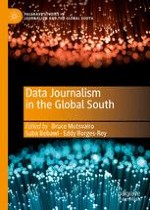2019 | OriginalPaper | Chapter
6. Data Journalism in the Age of Big Data: An Exploration into the Uptake of Data Journalism in Leading South African Newspapers
Authors : Dumisani Moyo, Allen Munoriyarwa
Published in: Data Journalism in the Global South
Publisher: Springer International Publishing
Activate our intelligent search to find suitable subject content or patents.
Select sections of text to find matching patents with Artificial Intelligence. powered by
Select sections of text to find additional relevant content using AI-assisted search. powered by
